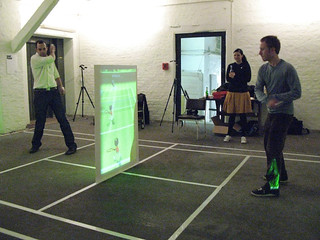Having researchers add the category of active video games / exergames to the list of activities on the Compendium of Physical Activities and the current inclusion in the NYPANS survey are great steps into letting more people to understand their potential. I worry however that they have not considered other categories of exergaming or game platforms besides the ones listed.
Brener ND, Eaton DK, Kann LK, McManus TS, Lee SM, Scanlon KS, Fulton JE, & O'Toole TP (2013). Behaviors Related to Physical Activity and Nutrition Among U.S. High School Students. The Journal of adolescent health : official publication of the Society for Adolescent Medicine PMID: 23796969
Abstract
National data related to physical activity (PA) and nutrition among adolescents are needed to help develop effective obesity prevention programs. The 2010 National Youth Physical Activity and Nutrition Study (NYPANS) was conducted to provide nationally representative data on behaviors and behavioral correlates related to healthy eating and PA.
NYPANS used a three-stage cluster sample design to obtain data representative of public- and private-school students in grades 9 through 12 in the United States (n = 11,429). Students completed an anonymous, self-administered questionnaire in their classrooms during a regular class period. Trained data collectors directly measured the students' height and weight at school using a standard protocol.
Analyses revealed that 19.0% of students were obese and 17.8% were overweight. Students participated in a range of physical activities during the 12 months before the survey; prevalence ranged from 5.0% for ice hockey to 83.9% for walking. In addition, 52.5% of students enjoyed the physical education classes they took at school. During the 7 days before the survey, 74.8% of students ate at least one meal or snack from a fast food restaurant, with black students more likely than white and Hispanic students to have done so. Forty-one percent of students always or most of the time have a TV on while eating dinner at home.
 These and other NYPANS results can be used to develop obesity prevention programs that address specific behaviors and behavioral correlates, and target subgroups in which behaviors and behavioral correlates related to obesity are most prevalent.
These and other NYPANS results can be used to develop obesity prevention programs that address specific behaviors and behavioral correlates, and target subgroups in which behaviors and behavioral correlates related to obesity are most prevalent.
 Staying connected is important for anyone, but especially for those with early staged of dementia and Alzheimer's disease, virtual reality may be one way to provide a close emotional connection in the absence of physical connection. Especially during the pandemic, virtual reality could be one means to keep older family members connected to the rest of the family.
Staying connected is important for anyone, but especially for those with early staged of dementia and Alzheimer's disease, virtual reality may be one way to provide a close emotional connection in the absence of physical connection. Especially during the pandemic, virtual reality could be one means to keep older family members connected to the rest of the family. 













































